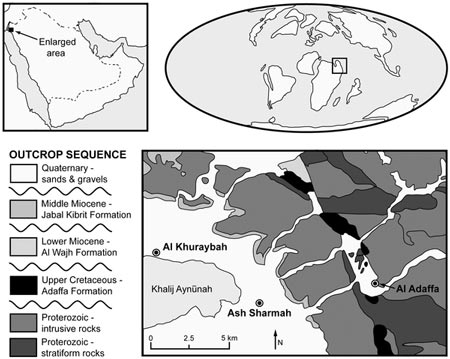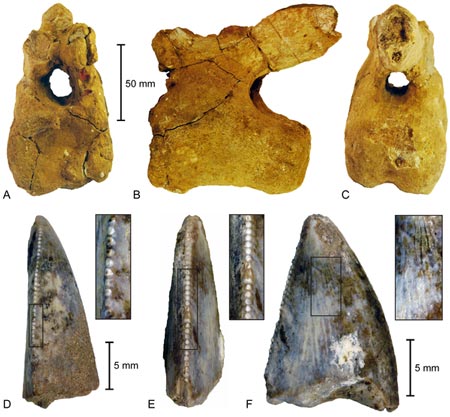Rare Dinosaurs from Saudi Arabia
Evidence of Abelisaurid and Enormous Titanosaur Discovered in Saudi Arabia
An international team of researchers including scientists from Museum Victoria, Monash University (Australia), Uppsala University (Sweden) and the Saudi Geological Survey have uncovered evidence of dinosaurs from Saudi Arabia. This is the first record of substantial dinosaur fossils being found in the Gulf State.
Dinosaurs from Saudi Arabia
A series of enormous vertebrae, identified as belonging to an as yet, unknown species of titanosaur and teeth fossils believed to have come from a large, carnivorous abelisaurid were found during a scientific expedition to explore the north-western part of the Saudi Kingdom, along the coast of the Red Sea (Adaffa Formation). During the Late Cretaceous, this part of the world, now famed for its extensive deserts, was a lush, verdant flood plain, the flora supported massive herbivores.
The rounded bones show signs of extensive abrasion the sort of damage associated with bones that were battered by waves and rolled around as a result of tidal action. This data and an analysis of the sedimentary strata itself supports the idea that these fossils were deposited close to the sea, perhaps in the mouth of an estuary.
The Location of the Fossil Discoveries
Picture credit: PLoS One
Upper Cretaceous Fossils
The illustration above shows the location of the fossil find in relation to modern-day Saudi Arabia, a map of the world during the Late Cretaceous indicating where on the Gondwanan margins the animal’s lived and a more detailed map of the strata from which the fossil material was excavated.
The strata from which the fossils have been excavated dates from the very end of the Age of Dinosaurs, (Campanian/Maastrichtian faunal stage) and an academic paper detailing the discovery has recently been published in the on line scientific journal PLoS One (public library of science).
Dinosaurs from the Arabian Peninsula
Dr Benjamin Kear, based at Uppsala University in Sweden and lead author of the study into these taxonomically identifiable Arabian dinosaurs commented:
“Dinosaur fossils are exceptionally rare in the Arabian Peninsula, with only a handful of highly fragmented bones documented so far. This discovery is important not only because of where the remains were found, but also because of the fact that we can actually identify them. Indeed, these are the first taxonomically recognisable dinosaurs reported from the Arabian Peninsula.”
Dr Tom Rich, Senior Curator (Vertebrate Palaeontology and Palaeobotany) at the Museum Victoria stated:
“Dinosaur remains from the Arabian Peninsula and the area east of the Mediterranean Sea are exceedingly rare because sedimentary rocks deposited in streams and rivers during the Age of Dinosaurs are rare, particularly in Saudi Arabia itself.”
At the time when these types of dinosaurs roamed, much of the landmass we know today as the Arabian peninsula was underwater. The titanosaur and the suspected abelisaurid lived on the area of land that formed the north-western coastal margins of the African continent.
The Fossils Found in Saudi Arabia
Picture credit: PLoS One
The sandy coloured objects at the top of the picture are the fossilised vertebrae of the titanosaur, the isolated teeth of the suspected abelisaurid can be seen below.
For models and replicas of Cretaceous titanosaurs and abelisaurids: CollectA Age of Dinosaurs Popular Models.
Fossil Finding Challenges
Explaining some of the problems about the lack of fossil material from Saudi Arabia, Dr Rich added:
“The hardest fossil to find is the first one. Knowing that they occur in a particular area and the circumstances under which they do, makes finding more fossils significantly less difficult.”
The abelisaurid is estimated to have been around six metres in length, the fossils from the plant-eating titanosaur indicate an animal perhaps in excess of 20 metres long. The recognition of titanosaurians and abelisaurids from Saudi Arabia extends the palaeo-geographical range of these groups along the entire northern Gondwanan margin during the very Late Cretaceous.
In addition, given the extreme rarity of dinosaurian fossil material from this part of the world, these fossils hint at the diversity of these types of dinosaurs throughout this region towards the end of the Mesozoic.
Everything Dinosaur is grateful for Museum Victoria (Melbourne, South Australia) for their help in compiling this article.



